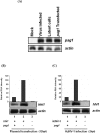A non-coding RNA of insect HzNV-1 virus establishes latent viral infection through microRNA
- PMID: 22355579
- PMCID: PMC3216547
- DOI: 10.1038/srep00060
A non-coding RNA of insect HzNV-1 virus establishes latent viral infection through microRNA
Abstract
Heliothis zea nudivirus-1 (HzNV-1) is an insect virus previously known as Hz-1 baculovirus. One of its major early genes, hhi1, is responsible for the establishment of productive viral infection; another gene, pag1, which expresses a non-coding RNA, is the only viral transcript detectable during viral latency. Here we showed that this non-coding RNA was further processed into at least two distinct miRNAs, which targeted and degraded hhi1 transcript. This is a result strikingly similar to a recent report that herpes simplex virus produces tightly-regulated latent specific miRNAs to silence its own key early transcripts. Nevertheless, proof for the establishment of viral latency by miRNA is still lacking. We further showed that HzNV-1 latency could be directly induced by pag1-derived miRNAs in cells infected with a pag1-deleted, latency-deficient virus. This result suggests the existence of a novel mechanism, where miRNAs can be functional for the establishment of viral latency.
Figures







Similar articles
-
MicroRNAs derived from the insect virus HzNV-1 promote lytic infection by suppressing histone methylation.Sci Rep. 2018 Dec 13;8(1):17817. doi: 10.1038/s41598-018-35782-w. Sci Rep. 2018. PMID: 30546025 Free PMC article.
-
Heliothis zea nudivirus 1 gene hhi1 induces apoptosis which is blocked by the Hz-iap2 gene and a noncoding gene, pag1.J Virol. 2011 Jul;85(14):6856-66. doi: 10.1128/JVI.01843-10. Epub 2011 May 4. J Virol. 2011. PMID: 21543471 Free PMC article.
-
The early gene hhi1 reactivates Heliothis zea nudivirus 1 in latently infected cells.J Virol. 2010 Jan;84(2):1057-65. doi: 10.1128/JVI.01548-09. Epub 2009 Nov 4. J Virol. 2010. PMID: 19889784 Free PMC article.
-
The role of microRNAs in viral infection.Prog Mol Biol Transl Sci. 2011;102:101-39. doi: 10.1016/B978-0-12-415795-8.00002-7. Prog Mol Biol Transl Sci. 2011. PMID: 21846570 Review.
-
The miRNAs of herpes simplex virus (HSV).Virol Sin. 2012 Dec;27(6):333-8. doi: 10.1007/s12250-012-3266-5. Epub 2012 Nov 9. Virol Sin. 2012. PMID: 23180288 Free PMC article. Review.
Cited by
-
Peste des petits ruminants virus infection of small ruminants: a comprehensive review.Viruses. 2014 Jun 6;6(6):2287-327. doi: 10.3390/v6062287. Viruses. 2014. PMID: 24915458 Free PMC article. Review.
-
Covert Infection of Insects by Baculoviruses.Front Microbiol. 2017 Jul 17;8:1337. doi: 10.3389/fmicb.2017.01337. eCollection 2017. Front Microbiol. 2017. PMID: 28769903 Free PMC article. Review.
-
Viral lncRNA: A regulatory molecule for controlling virus life cycle.Noncoding RNA Res. 2017 Mar 23;2(1):38-44. doi: 10.1016/j.ncrna.2017.03.002. eCollection 2017 Mar. Noncoding RNA Res. 2017. PMID: 30159419 Free PMC article. Review.
-
Polydnaviruses: From discovery to current insights.Virology. 2015 May;479-480:393-402. doi: 10.1016/j.virol.2015.01.018. Epub 2015 Feb 7. Virology. 2015. PMID: 25670535 Free PMC article. Review.
-
Adventitious viruses in insect cell lines used for recombinant protein expression.Protein Expr Purif. 2018 Apr;144:25-32. doi: 10.1016/j.pep.2017.11.002. Epub 2017 Nov 10. Protein Expr Purif. 2018. PMID: 29133148 Free PMC article. Review.
References
Publication types
MeSH terms
Substances
LinkOut - more resources
Full Text Sources
Other Literature Sources
Medical

